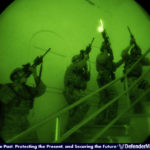
10/12/2017 – SOUTHWEST ASIA (AFNS) — At any given moment, the 386th Expeditionary Security Forces Squadron stands ready to protect, defend and fight against all threats to the 386th Air Expeditionary Wing. Among those men and women who guard the wing’s high valued assets and people, is a newly formed group of defenders who dedicate their time, on-duty and off, to train for high risk situations.
After an extensive selection process, the 386th ESFS High Risk Response Team was established in August 2017. The team is a highly trained response force, much more than the typical first responder.
“We wanted to start the HRRT to have the flexibility and capability to better react to any critical response scenarios,” said Capt. Cory Cook, 386th ESFS operations officer. “If a situation arises that requires specially trained personnel, we will bring the HRRT. The teams are always on alert and there is always a team prepared to respond in a moment’s notice.”
The team focuses on close-quarters combat to effectively control any complex situations such as hostage situations, barricaded subjects, buildings rigged with explosives, aircraft hijackings and active shooter scenarios, to name a few.
“The importance of a team that can neutralize a threat, dominate a structure, lock down and clear the buildings within minutes is phenomenal,” said Tech. Sgt. Domenic Mash, 386th ESFS training manager, deployed from the Pittsburgh International Airport Air Reserve Station. “Limiting casualties in any situation is the number one goal.”
“The HRRT is important for responding to scenarios that require a particular set of skills in order to neutralize threats while limiting the potential of serious injury or harm to innocent personnel,” said Cook.
Expanding on its skill sets, the HRRT recently incorporated military working dogs and coalition partner forces into its training.
“The importance of having K-9 is pretty obvious; they can detect people as well as explosives to keep the team as safe as possible,” said Mash. “Working with coalition military police ups our manning, gets more guns into the fight, and with them integrating with us, it allows them to know our movements and tactics, techniques and procedures.”
The total force team regularly trains together to improve its tactics, techniques and procedures with intentions of continuously expanding its training to meet any type of threat that could be encountered.
This highly trained response force is comprised of defenders who have full-time duties other than the HRRT. These dedicated Airmen devote their free time, training around the clock to maintain their readiness to defend U.S., coalition and host nation personnel, fight all adversaries during high risk operations and to preserve the ability to deliver decisive airpower.
By Tech. Sgt. Jonathan Hehnly,
386th Air Expeditionary Wing Public Affairs

